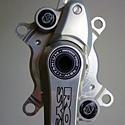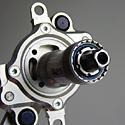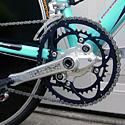
Recently on Cyclingnews.com |
Tech review - March 16, 2004
Rotor RS4 crank
Ben Larsen reviewed Rotor's unusual cam action crank on Cyclingnews two years ago and pronounced himself a convert. In this follow-up to that test, he looks at the latest incarnation, the Rotor RS4.

|
Almost two years ago I saw my first pair of Rotor RCK cranks and viewed them somewhat cynically as another iteration in the ongoing battle to reduce the so-called 'dead spots' in a cyclist's pedaling action and improve efficiency. My own initial training and racing on the Rotors suggested there was merit to Rotor's efficiency claims and that it was a genuine 'performance-enhancing' piece of equipment.
Since then, the RS4 model of the Rotor crank has been released; debate has raged unabated over their effectiveness; my own opinion has been changed; and looks like that the final credibility frontier is on the horizon (from the manufacturer's view at least) with several European pro cyclists planning to use them in time trials in major races this year.
From a technical perspective, the Rotor crank has been refined since inception from a system that required complete integration with a custom frame, to the current design that fits to almost any bike with a standard bottom bracket. The subsequent changes from the RS03 model I tested in 2002 to the current RS4 units are comparatively subtle but are indicative of a manufacturer who is listening to its public - this has been more than a simple face-lift.
From a personal perspective, I had trained and raced over 15,000km on a pair of the RS03 cranks and have now trained, road raced, time-trailed and triathloned another 5,000km on the new RS4 cranks. For me, this has become more than a product evaluation - the rotors have become my standard race equipment in triathlons and time trials.
What has changed?

|
The aesthetics have changed. The cranks are now slightly more styled with a black etched logo rather than the old engraved logo, dust caps on the cams and black anodised chainrings. Improved aesthetics don't change the performance of the product but the black chainrings certainly make them stand out in a crowd.
The chainrings have changed. The new chainrings are anodised black (as above) but significantly the large chainring now has six CNC-machined shifting ramps and pins together with profiled teeth to really improve shifting up, especially under load.
The bottom bracket design has changed. The bottom bracket is now a left cup assembly, just like a standard Shimano sealed BB. This is significant from an installation standpoint in that you use the same tool as Shimano, but also in that Rotor has dropped the beveled lock-ring design of the RS03 that required a little more skill to install and risked damaging the BB thread if you got it wrong.
The seals have changed. The cams and the rotor mechanism introduce movement that's absent in a normal fixed crank and in the RS03 there was a level of resistance that you could feel while turning the cranks by hand (I never really noticed it while riding though). The seals and bearings of the RS4 have been improved to reduce this resistance and it is now significantly smoother, comparing the two directly by hand.

|
The offset has changed. On the road model, the maximum offset of the cranks has been reduced from 15º to 12º. This means that at the easiest setting (meant for tourists and the like) the cranks are not as offset as they could be on the RS03 model. It is also at this setting that Rotors initially felt the strangest, so reducing this might make the adaptation easier for some people who start on the easy setting. I tend to run mine at the hardest settings (meant for time trialists and maximum power) so it has not really changed for me.
There are a few other changes which Rotor make note of but that I have not really noticed or needed to notice in my use of the unit. Rotor claims the new modular assembly allows for easier and more efficient installation, lubricating and cleaning. I found it easier to install due to the improved BB design but otherwise did not find it much different. Cleaning and lubrication are no fuss on either model and I haven't needed to pull mine apart.
Rotor claim biomechanical performance improvements through the re-design of the power output curves making more efficient pedaling and a faster, natural adaptation. Again this may be the case, but the difference is probably fairly subtle. The adaptation period for most riders is from a few days to two weeks anyway so this may drop a day or two from the process.
Rotor now offers more crank lengths including 165mm along with the 170, 172.5, 175 and 180mm previously available in the RS03, making the RS4 an option for smaller riders.
What hasn't changed?

|
They still work, for me at least. I have spoken about Rotors with many people over the last two years and seen much of the online discussion and comparison of Rotors but the bottom line for me is that in a time trial situation I am still quicker with Rotors than without. The testimony of most other users tends to reflect the same although some of the claimed improvements of 5kph+ by some riders would suggest that other changes might be contributing to their gains. From my own experiences, I'll stick with my 1.5-2 minutes/hour for a sub-60-minute 40km rider and perhaps slightly more for a slower rider.
Further testing
When I received the new RS4s I set up John, a local 45 year old veteran rider with the RS03s to see if my own gains were reflected in his results. Over a period of four months I got John to ride the same 10km TT regularly on his normal cranks and he improved from mid 18 minutes to low 18 minutes for the course but never managed to break the 18-minute mark. Three days after installing the Rotors we got John on the same course clocking 17:30. John has subsequently repeatedly matched the same time and even gone marginally faster. At this pace he still is not going to break any world records but it is undoubtedly a significant improvement that he would not have gained otherwise. I have not managed to get him to ride longer TTs but would suggest that his improvements would be close to Rotor's claims of three minutes per hour.
Summary
In terms of the changes, the set-up has improved because they are a little easier to install, the shifting has improved with the shifting ramps on the big ring, the resistance has improved a little and the aesthetics have got a little bit slicker.
In terms of the Rotor crank's performance, I could not say with any confidence that the RS4s are any faster than the RS03s. What I am confident about is that these cranks are faster than my Dura-Ace cranks in a time trial situation.
The skeptics will always have their views and they are entitled to them. I don't always need to understand why something works as long as it works, in the case of these cranks I am willing to defer judgment to the stopwatch, which so far has been fairly positive.
Recommended retail price: US$810
Pro: Improved looks and seals, better bottom bracket installation
Con: Still a weight penalty over standard cranks
More information: Rotor
System website
Cyclingnews Rating: ![]()

